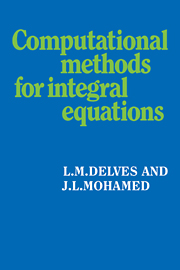Book contents
- Frontmatter
- Contents
- Preface
- 0 Introduction and preliminaries
- 1 The space ℒ2(a,b)
- 2 Numerical quadrature
- 3 Introduction to the theory of linear integral equations of the second kind
- 4 The Nystrom (quadrature) method for Fredholm equations of the second kind
- 5 Quadrature methods for Volterra equations of the second kind
- 6 Eigenvalue problems and the Fredholm alternative
- 7 Expansion methods for Fredholm equations of the second kind
- 8 Numerical techniques for expansion methods
- 9 Analysis of the Galerkin method with orthogonal basis
- 10 Numerical performance of algorithms for Fredholm equations of the second kind
- 11 Singular integral equations
- 12 Integral equations of the first kind
- 13 Integro-differential equations
- Appendix: Singular expansions
- References
- Index
0 - Introduction and preliminaries
Published online by Cambridge University Press: 07 December 2009
- Frontmatter
- Contents
- Preface
- 0 Introduction and preliminaries
- 1 The space ℒ2(a,b)
- 2 Numerical quadrature
- 3 Introduction to the theory of linear integral equations of the second kind
- 4 The Nystrom (quadrature) method for Fredholm equations of the second kind
- 5 Quadrature methods for Volterra equations of the second kind
- 6 Eigenvalue problems and the Fredholm alternative
- 7 Expansion methods for Fredholm equations of the second kind
- 8 Numerical techniques for expansion methods
- 9 Analysis of the Galerkin method with orthogonal basis
- 10 Numerical performance of algorithms for Fredholm equations of the second kind
- 11 Singular integral equations
- 12 Integral equations of the first kind
- 13 Integro-differential equations
- Appendix: Singular expansions
- References
- Index
Summary
This book
The theory of differential equations is an essential ingredient of any undergraduate course in Mathematics and the majority of Numerical Analysis undergraduate courses introduce the student, at an early stage, to the numerical solution of differential equations. For some reason the theory, and, perhaps more so, the numerical solution, of integral equations are deferred to a later stage: in some sense integral equations must be felt to be either more advanced or of less practical interest than differential equations. This reflects the situation in practical calculations and probably in turn helps to perpetuate it; we turn more readily to a differential formulation of a problem than to an integral formalism. Yet the theory of linear nonsingular integral equations is at least as well developed as that of differential equations and it is in many respects rather simpler. The corresponding operators are bounded rather than unbounded, leading to a very straightforward existence theory (the Fredholm theory); perhaps, as one consequence of this, there is a much tighter link between the theory and practice of integral equations than is the case with differential equations. Most of the convergence proofs are constructive in nature and all or nearly all of the constructions have been used as the basis of algorithms for the numerical solution of the underlying equations (although not always with any great success!).
- Type
- Chapter
- Information
- Computational Methods for Integral Equations , pp. 1 - 11Publisher: Cambridge University PressPrint publication year: 1985



